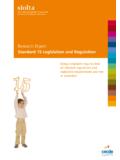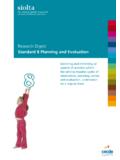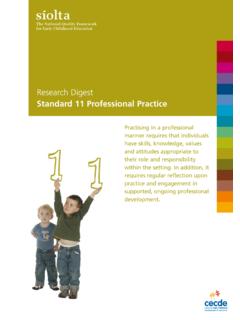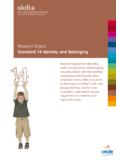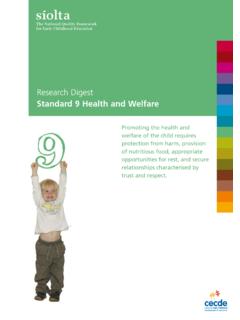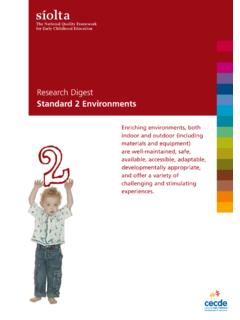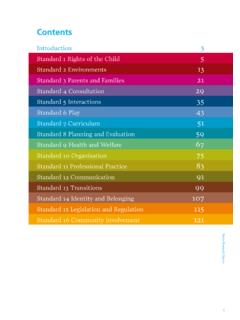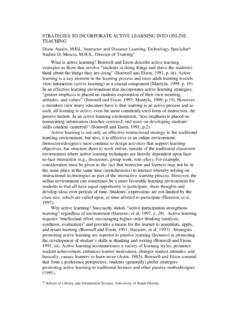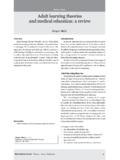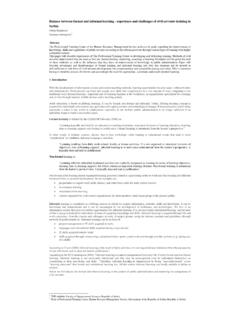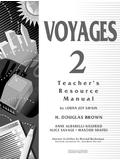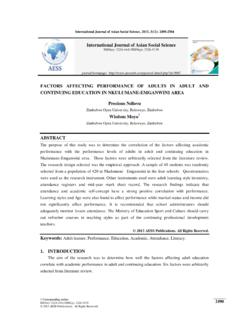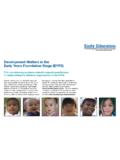Transcription of Research Digest - Síolta
1 The National Quality Framework for Early Childhood Educations oltaResearch Digest Standard 6 PlayPromoting play requires that each child has ample time to engage in freely available and accessible, developmentally appropriate and well-resourced opportunities for exploration, creativity and meaning making in the company of other children, with participating and supportive adults and alone, where appropriate. Research Digest s olta Play Research Digest s olta PlayIntroductionPlay is one of the key contexts for children s early learning and development, and offers significant opportunities for both learning and teaching. Play at its best in education situations, provides not only a real medium for learning but enables discerning and knowledgable adults to learn about children and their needs.
2 (Moyles, 1989:xi)The challenge for practitioners who work to support the young child s learning and development is to engage with the child s play in a way which enhances it and opens up new vistas of learning and order for it to be enjoyable and beneficial, young children need to spend a significant amount of time within the setting engaged in play/exploration, and these and other playful activities should be central to the daily routine. An understanding of child development is central to the achievement of this, primarily as it provides a continuum on which the practitioner can determine what is developmentally appropriate in terms of play. While singing and rhyming may be used to engage in play with very young babies, for example, interactive story-time may be more developmentally appropriate for older important feature of play is that it enables the child to explore, to be creative and to use her/his previous learning to make new meanings.
3 Open-ended play items, for example, can be provided which lead the child to explore different properties in the environment, both indoor and outdoor. The next section of the Research Digest considers these aspects of play and their relationship to quality practice, as well as providing Research evidence around resourcing play and the importance of choice and interaction. Recent ResearchPlay, learning and development In play, children develop and demonstrate exploration, creativity, spirituality, imagination, experimentation, manipulation, expression of ideas, social and interaction skills, divergent and abstract thinking, and problem-solving capacities (Bruce, 001). These skills are essential for the consolidation of learning and the construction of meaning and knowledge.
4 Research has demonstrated that young children who are more engrossed in their free play (thereby demonstrating higher levels of motivation) manifest more cognitively sophisticated play than peers who are less engrossed. Furthermore, adults who demonstrate warmth and supportive responses positively influence task-directedness, organisation, sustained play activity and pride in personal achievement in young children (CECDE, 005). While children are biologically primed to play from birth, they need other people to trigger those biological processes (Bruce, 001). Babies need sensitive adults who will not allow frustrations to develop. If the joy of play goes, it takes with it the potential for deep learning .
5 Toddlers develop the capacity to engage in critical aspects of play; pretending, imagining, and creating props for play with role rehearsals. They begin to use symbols and develop mastery of new activities. Whereas struggle is an important feature of early learning , children who are always struggling will become reluctant learners if they do not get enough practice to gain the dexterity they need in order to enjoy what they have learnt. The enjoyment of writing stories has its roots in socio-dramatic play in which the child develops scenes with a story line and adventurous characters (Bruce, 001). The literature further emphasises that structured play should provide both security and intellectual challenge; these two factors are largely determined by the developmental appropriateness of the activities (CECDE, 005).
6 Children who learn actively from birth are more likely to have positive dispositions to learning . This has life long implications. These children are curious and interested in what they are doing and they experience fun, enjoyment and, with repetition, the Research Digest s olta Playprobability of success. They develop competence and subsequent confidence. Open, optimistic, risk-taking and resilient, they are intrinsically motivated to learn (French, 007). Resourcing play David et al. ( 00 ) have noted the one hundred languages that children use daily to share and communicate their ideas playfully. These include singing, dancing, talking, story-making, painting, mark-making, patterns, building, animating puppets and other playthings, model-making, gardening, looking after animals, and so forth.
7 Such playful activity needs to be encouraged at all stages of the day and not confined to specific periods even routine activities can be done playfully. If play is to be seen as a process that will promote learning and development, it must be of high quality (In-Career Development Team, 1998). Lack of resources in the form of appropriate equipment and high pupil:teacher ratios can result in a gap between child-centred curriculum provision and its implementation (Murphy, 004). High quality play is nurtured by adults providing a resource rich and aesthetically pleasing environment (indoors and outdoors) where children are able to touch, manipulate, explore, and experiment with a variety of materials.
8 Socio-dramatic play can be supported by both specific materials such as a train set or dressing-up clothes, or more open-ended items such as blocks or big and small boxes. The latter are more likely to support more imaginative and complex play scripts (In-Career Development Team, 1998). Play is an extensive pathway to learning and as such, professional knowledge and expertise is critical in planning and engaging in playing, learning and teaching (Murphy, 004). This involves practitioners developing informed insights into the styles and patterns of learning for each child; her/his preferences, needs, identities, friendships and interests, and extending their own knowledge about pedagogical processes and curriculum.
9 Play provides a lens into children s minds, revealing meanings and patterns not evident in formal contexts. It can help practitioners to understand the meaning of play-based and child-initiated activities, to fine tune their provision, to help children to become 4 Research Digest s olta Playmaster players and to inform the co-construction of the curriculum (Wood and Attfield, 005). The skill of the practitioner lies in fusing the developmental needs of children with the concepts and values required for progression in any area of learning . Curriculum plans need to be reflected on daily, to identify, for example: What the children learned that day How the specific needs of children were addressed What special interests can be built upon How each child can be helped to experience success tomorrowMaterials and activities offered will consequently prove to be more diverse, challenging, appropriate to the context of development and enriching in generating critical skills (French, 00 ).
10 Choice and interaction The importance of activity and first hand experiences (where children can touch, smell and taste as opposed to looking at photographs or plastic replicas) in supporting children s early learning and development is dependent on the adult s role in providing for and enriching this activity. Children must have access to a range of stimulating materials and experiences. Adults should provide children with learning opportunities for responsible choice and independence. Babies need access to objects to explore and discover their weight, smell, texture, as well as colour, in a safe environment. The adult is in a position, having carefully laid out the objects and checked for safety, to facilitate the child s exploration in freedom.

